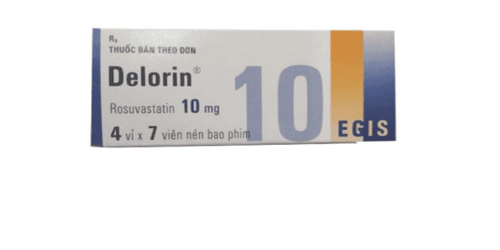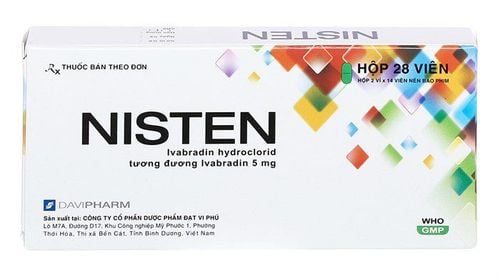This is an automatically translated article.
Pelearto 20 is mainly used to treat hypercholesterolemia. Before and during the use of Pelearto, patients should carefully read the instructions and strictly follow the medication regimen as prescribed by the specialist.
1. What is Pelearto 20?
Pelearto 20 belongs to the group of lipid-lowering drugs to help treat hypercholesterolemia, manufactured by Savi Pharmaceutical Joint Stock Company. Pelearto is prepared in the form of film-coated tablets, with the packaging of 3 blisters x 10 tablets and contains the main ingredient is Atorvastatin (20mg content).
2. Indications and uses of Pelearto 20
2.1. Indications to use Pelearto 20 What disease does Pelearto 20 treat? As recommended, Pelearto is prescribed for the following conditions:
As an adjunct to diet in the treatment of elevated total cholesterol, bad cholesterol (LDL), apolipo-protein B and triglycerides, copper. It also helps to raise good cholesterol (HDL) in the blood in the following patients: People with primary hypercholesterolemia (non-familial or heterozygous). People with mixed hyperlipidemia (including groups lIa & llb according to Fredrickson classification). People with hypertriglyceridemia (Fredrickson class IV). People with beta-lipoproteinemia (group III Fredrickson classification) do not respond adequately to total cholesterol reduction. Pelearto 20 is used to help treat hypercholesterolemia (LDL) in patients with homozygous familial hypercholesterolemia when other medications or the usual diet have not been effective. Full results as expected. 2.2. Uses of the drug Pelearto 20 Pharmacodynamics:
Active ingredient Atorvastatin in Pelearto belongs to the group of HMG-CoA reductase inhibitors, capable of blocking the production of cholesterol in the liver. Atorvastatin helps to reduce total cholesterol and bad cholesterol in the blood, thereby slowing the progression and even reversing coronary heart disease. Unlike other HMG-CoA reductase inhibitors, Atorvastatin works to reduce blood triglyceride levels, which helps reduce the risk of coronary heart disease. Pharmacokinetics:
Absorption: Atorvastatin is rapidly absorbed from the gastrointestinal tract, with low bioavailability (>60%) due to extensive first-pass metabolism in the liver. It is estimated that peak plasma concentrations of Atorvastatin are 1-2 hours. Distribution: Active substance Atorvastatin tends to be strongly bound to plasma proteins (> 98%). In addition, Atorvastatin can cross the blood-brain barrier due to its lipophilic properties. Metabolism: Atorvastatin is metabolized to with / without activity mainly in the liver (more than 70%) Elimination: Atorvastatin is eliminated mainly in the faeces and only < 2% by the kidneys.
3. Dosage and instructions for using Pelearto 20
3.1. Dosage of Pelearto 20 Dosage of Pelearto drug will be determined specifically based on the medical condition and treatment goals of each patient:
Treatment of hypercholesterolemia (heterozygous/familial) familial) and mixed dyslipidemia:
Use a starting dose of 10 - 20mg / time / day. For patients requiring >45% reduction in LDL cholesterol levels, an initial dose of 40mg once daily may be used. The therapeutic dose range for Pelearto drug ranges from 10 - 80mg / time / day, ie not to exceed 80mg. After starting treatment or increasing the dose of Pelearto, the patient's blood lipids within 2-4 weeks should be carefully assessed for an appropriate dose adjustment. Treatment of homozygous familial hypercholesterolemia:
Oral dose of Pelearto from 10 to 80mg / time / day. Pelearto can be used in combination with other lipid-lowering measures. Combination therapy: Using Pelearto for treatment in combination with Resin enhances the treatment effect.
Pelearto dose for patients with renal impairment : No dose adjustment is required.
3.2. Instructions for use of Pelearto 20 According to recommendations, patients can start treatment for hypercholesterolemia with the lowest dose of Pelearto that the drug works. If necessary, the physician can adjust the dose of Pelearto according to the needs and response of each patient by increasing the dose gradually, spaced not less than 4 weeks apart. In addition, patients should also be closely monitored for adverse drug reactions, especially those affecting the muscle system.
Not only that, before starting treatment with Pelearto 20, patients also need to make a reasonable diet and maintain them throughout the course of taking the drug.
Because Pelearto is in tablet form, patients need to swallow the tablet whole rather than crushing, chewing, or sucking. Ideally, the drug should be taken with filtered water, avoid using with other drinks, especially alcohol and sweeteners.
4. Possible side effects when treated with Pelearto 20
During the treatment of hypercholesterolemia with Pelearto 20, patients may experience some unwanted reactions on some organs in the body, such as nerves, muscles, liver,... Possible:
Hematopoietic organs: Causes low platelet count (rare frequency). Immune system: Anaphylaxis (rare). Metabolism and nutrition: Increased blood glucose levels (common, should be used with caution in diabetics), anorexia or weight gain. Psychiatric system: Insomnia or nightmares (uncommon). Nervous system: Dizziness, headache, dysesthesia, forgetfulness, weakness or insomnia. Vision: Blurred vision or visual disturbances (rare). Hearing: Tinnitus or hearing loss (rare). Respiratory organs: Sore throat, sore throat or nosebleed. Digestive system: Constipation, diarrhea, nausea or flatulence (common, requiring caution), vomiting or pancreatitis (may occur). Hepatic: Cholestatic liver failure, hepatitis or increased transaminases. Skin and subcutaneous tissue: Rash, urticaria, pruritus (uncommon), more serious Stevens-Johnson syndrome, angioedema and toxic epidermal necrolysis. Musculoskeletal: Muscle/joint pain, muscle weakness, acute rhabdomyolysis or muscle fatigue. Genital organs: Gynecomastia (very rare). In addition to the above effects, Pelearto can also cause some other common side effects such as fatigue, chest pain and irritability. When any noticeable symptoms occur, the patient should discontinue the drug (especially in the presence of signs of an allergic reaction) and notify the physician for alternative medication options. In addition, to prevent the side effects of Pelearto 20, patients need to carefully read the ingredients printed on the packaging to make sure they do not have a history of allergies related to them.
5. Some important notes when treating with Pelearto 20
Pelearto should be avoided in the following cases:
Patients with a history of allergy or hypersensitivity to the active substance Atorvastatin in particular as well as HMG-CoA reductase inhibitors (Statins) in general and any excipients any other pharmacy in Pelearto. People with active liver disease. People with elevated transaminase levels (more than 3 times the normal limit). People who are taking Ritonavir in combination with Tipranavir, or are taking medicines such as Glecaprevir, Telaprevir or Pibrentasvir. Children under 18. Women who are pregnant / suspected of being pregnant, or women who are breastfeeding. Before and during the use of Pelearto 20, patients need to be cautious of some of the following:
Considerations when co-administering with Statins, especially patients at high risk of muscle damage, easy to lead to musculoskeletal effects such as myositis and muscle atrophy. Pelearto 20 should also be used with caution in patients with kidney disease, uncontrolled hypothyroidism or over 65. Muscle damage is significantly increased if Pelearto 20 is used together with fibrates. , Gemfibrozil and high doses of niacin,... Patients should be cautious when using lipid-lowering drugs of the Statins group with drugs for hepatitis C and HIV because they can increase the risk of muscle damage, especially rhabdomyolysis, renal failure due to kidney failure. Before deciding to treat with Pelearto 20, patients need to control hypercholesterolemia by exercising, eating healthy, treating other medical conditions, and losing weight in obese patients. Use of Pelearto 20 may increase transaminases and creatinine phosphokinase. The following are recommendations regarding the potential for interactions between Pelearto 20 and some other drugs, specifically:
Avoid taking Pelearto with Telaprevir / Ritonavir + Tipranavir: The combination use of Pelearto with enzyme inhibitors CYP3A4 may increase plasma concentrations of the active substance Atorvastatin, resulting in a higher risk of myopathy or myopathy. There is an increased risk of muscle damage when atorvastatin is used in combination with other drugs such as Gemfibrozil, Itraconazole, Cyclosporin, Erythromycin, Ketoconazole, Colchicine, other Fibrate-lowering agents or niacin doses > 1g/day. The combination of Amiodarone with Pelearto should be avoided because it may increase the risk of rhabdomyolysis. Pelearto should not be co-administered with Oral Antacid Suspension containing Aluminum hydroxide and Magnesium as this may reduce plasma concentrations of active substance Atorvastatin by up to 35%. A 25% reduction in plasma concentrations of Atorvastatin when Pelearto is used in combination with Cholestyramine. Increased plasma concentrations of Digoxin (approximately 20%) with concomitant administration of Pelearto and Digoxin. Avoid taking Pelearto with Erythromycin and oral contraceptives containing Ethinyl estradiol and Norethindrone. Grapefruit juice should be avoided with Pelearto because it can increase blood levels of the drug. Above are the uses and doses of Pelearto. To ensure safety and maximize the effectiveness of treatment, patients should carefully read the instructions for use, consult a doctor / pharmacist before use.
Please dial HOTLINE for more information or register for an appointment HERE. Download MyVinmec app to make appointments faster and to manage your bookings easily.













